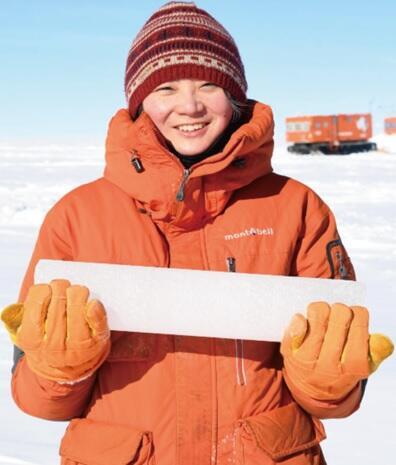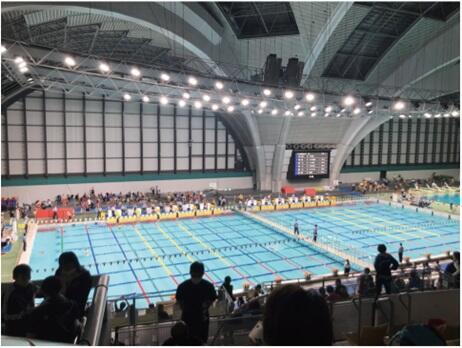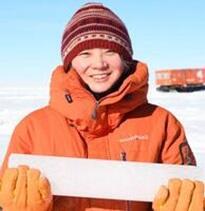
Assistant Professor of the Division for Collaborative Research Promotion (Meteorology and Glaciology Group and Ice Core Research Center) at the National Institute of Polar Research
Assistant Professor of the Polar Science Program at the Graduate Institute for Advanced Studies at SOKENDAI
Q1. What inspired you to become a researcher?
A1. I became interested in the environment through comic books and extensive studies.
My interest in the Earth and the natural environment began with a comic book I read in my elementary school library, The Miracle Planet. Later, during my integrated studies in high school, I researched global warming and learned that "changes in deep ocean circulation can drastically alter the Earth's climate." At the time, there was a growing interest in global warming due to the adoption of the Kyoto Protocol and other factors. On the other hand, there was also strong skepticism and denialism, and it was difficult to know the facts from the vast amount of information available on the internet. This experience strongly motivated me to clarify what is correct information, which led me to become a researcher.
To understand "why the Earth's environment is changing," we should look at past climate change. There are several ways to do this. I learned about "ice cores" drilled in the Antarctic and Greenland ice sheets during an intensive course at Kobe University. I was also attracted to the beauty of snow and ice, which I was familiar with in Hokkaido, where I spent my childhood and graduate school years, and I wanted to deepen this research, which led me to the Polar Research Institute.

Q2. Please tell us about your ice core investigations and research
A2. I participated in a polar expedition, collected samples, and reconstructed Antarctic snow accumulation variations over the last 5,000 years.
Ice cores contain particles and chemical components, such as carbon dioxide (CO2), methane, and aerosols, that are preserved like a time capsule. By investigating these components, we can explore Earth's past climate changes. So far, I have participated in field observations in Greenland in 2015 and 2018 and in Antarctica in 2017-18, including drilling for ice cores. On the first day of my first Greenland observation, I was hit by a blizzard so bad that I could not even see the tent next to me, and I thought, "I want to go home" many times. However, when the weather cleared up after the blizzard, I forgot about the hardships and devoted myself to observation all day.
For the FOREST research project, I try to reconstruct atmospheric CO2 concentrations and climate changes from Antarctic ice cores at ultra-high temporal resolutions over the past million years on a 100-year scale. In 2023, I conducted a high-precision analysis of ice cores and snow samples from the Dome Fuji area in the interior of Antarctica and reconstructed snow accumulation variations over the past 5,000 years.
The analysis showed that the accumulation rate decreased from 5,000 years ago to the Industrial Revolution due to long-term cooling and sea ice expansion in the Southern Ocean. In contrast, the accumulation rate increased significantly after the Industrial Revolution, forced by increased moisture transport to inland Antarctica due to greenhouse gas increases and ozone depletion. I believe that ice core data can contribute to elucidating the mechanisms of climate change as input data and validation for climate and ice sheet simulations.

Q3. What are your future goals and what is important to you?
A3. I would like to establish a laboratory and strive for high-precision analysis. A drastic change in environment has been a positive experience.
Although parts of research are tedious and difficult, there is no substitute for the excitement I feel when I am able to read new signals of climate change. Now, I am in the process of launching a new laboratory and would like to continue to improve the precision and accuracy of ice core analysis.
I was a liberal arts major in high school but went on to study science in university. I think it is important not to think that it is impossible from the beginning, but to take the plunge and try to change the environment around you.
Learning with curiosity to refine one's topic is a big plus during one's student years and in one's life as a researcher. I hope that those of you who are pursuing research careers will also look at the wider world and deepen your own interests.
(TEXT: Manami Yokoi)

Profile
Ikumi Oyabu
Assistant Professor of the Division for Collaborative Research Promotion (Meteorology and Glaciology Group and Ice Core Research Center) at the National Institute of Polar Research
Assistant Professor of the Polar Science Program at the Graduate Institute for Advanced Studies at SOKENDAI
Grew up in Hokkaido, she received her PhD (Doctor, Environmental Science) from the Division of Earth System Science at the Graduate School of Environmental Science at Hokkaido University, in 2015. After working as an academic researcher at the Institute of Low Temperature Science, Hokkaido University, and as a postdoctoral researcher at the National Institute of Polar Research (NIPR), she has been in her current position since 2023. She has been a Fusion oriented Research for disruptive Science and Technology (FOREST) researcher since 2022.




